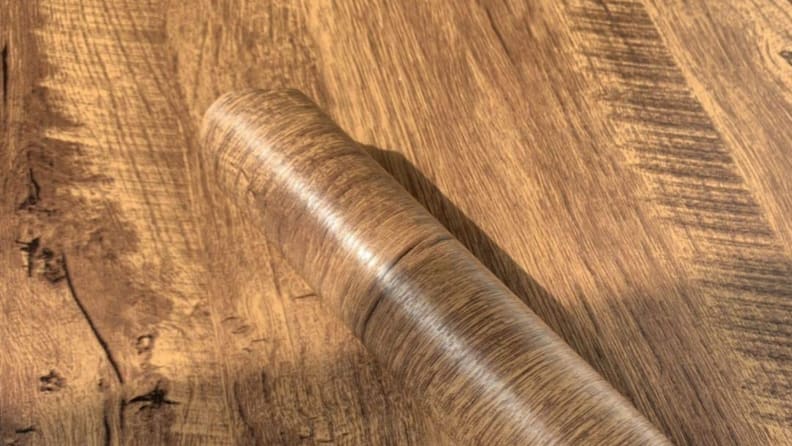 Credit:
Reviewed / Felicity Warner
Credit:
Reviewed / Felicity Warner
Products are chosen independently by our editors. Purchases made through our links may earn us a commission.
When the itch to update your current space comes, it’s hard not to scratch it.
Since many of us have been home for eight months-plus staring at all our old furniture and décor dreaming of new pieces as we’ve worked remotely, I’ve noticed a few items in my home that I’ve wanted to upgrade but don’t really have the budget to upgrade—at least with new, comparable items.
In particular, I own a plain dresser that I’ve wanted to replace with a brand new piece that feels more my taste, which is retro and stylish. However, to curb the cost—not to mention the hours of putting together said dresser—I opted instead to spruce up my dresser with something inexpensive and temporary.
By taking a DIY route and using decorative contact paper to change the look of my dresser, I was able to completely transform its vibe. And, I was able to do it for under $30.
Guess what? You can do this project, too. Spruce up a drab countertop, coffee table, kitchen cabinet, or end table—the options are endless.
Here’s what I did, so you can try your own hand at upgrading your furniture.
What is decorative contact paper?

This particular contact paper from Amazon was stunning and looked even more realistic once I got to see it in person.
Contact paper is essentially removable, adhesive wallpaper—also called peel and stick wallpaper—available in different types of patterns, finishes, and textures.
From decorative backsplash designs to ultra-realistic faux stainless steel, contact paper can recreate the look of classic materials, without the need for a complete overhaul.
Homeowners can go wild with contact paper, but it’s also a great option for renters who can’t replace a fixture, like countertops, in an apartment they don’t own.
What you’ll need

I ended up using both smoothing tools—the smaller one came in handy for the little details and nooks.
- Contact paper — this is the exact one I used from Amazon
- A precision craft knife
- A wallpaper smoothing tool—one will do, but having a small and a large version helps to smooth specific spots
- 3-4 hours, depending on how much surface you’ll be covering with contact paper
I ended up opting for a wallpaper smoothing tool kit that includes a precision knife with multiple replacement blades, one large smoothing tool, and one smaller one with a felt edge for gentler smoothing.
1. Measure your piece of furniture or space
Don’t end up with too little or too much decorative contact paper—make sure you measure the length, width, and height of your furniture using a ruler. For a counter space or coffee table surface, you’ll only need to grab the length and width.
Once you’ve written down the dimensions, add a few inches to each measurement, just in case.
For this specific dresser, I knew I would need a little extra contact paper for the small details of the drawers, so I planned accordingly with the measurements.
2. Decide on your contact paper
I searched online for some inspiration on current design trends, which helped give me a better idea of what style contact paper to choose. There was a lot to choose from—marble contact paper, stone, brick, modern geometric shapes, lively floral patterns, and so much more.
I’ve always loved the Mid-century modern look, which shows a lot in my home, and I wanted this dresser to reflect that.
So, I decided to go for a light, slightly distressed wood contact paper, and I scoured the web for the perfect paper that looks nearly identical to real wood.
The best advice I can offer for ensuring that the contact paper will look just as good in real life as it does online is to search out several reviews with photos.
3. Thoroughly clean your furniture or wall
Whether you’re adding the contact paper to a bathroom countertop, a desk, or a portion of the wall, you need to start with a clean surface.
I used warm water and gentle dish soap with a washcloth to gently remove oil, dust, and dirt that had built up on the dresser.
Make sure your surface is dry before you begin applying contact paper.
4. Now for the fun part: application

If you have someone to help you, it can make it easier if one person is removing the adhesive and the other is gently pressing with the smoothing tool.
In preparation for my DIY project, I read dozens of how-to guides for the best ways to apply contact paper.
The general consensus was to measure and cut your contact paper, then paste it on. However, if you’re working with any sort of uniquely shaped item that isn’t just a flat and simple surface, I promise you this is not the best technique.
My dresser has curved drawers rather than traditional rectangle drawers with knobs, which made it nearly impossible to trace, cut, and apply with a perfect alignment. After trying this and failing a couple of times, I decided to apply a large rectangle of contact paper on the drawer, then do the cutting and trimming. Make sure the rectangular piece has at least a few more inches on its length and width to give yourself some breathing room.

Continue to smooth the edges and surface continuously throughout the process to rid of any air bubbles before it’s too late.
While applying the decorative contact paper, use one hand to peel its backing off (it looks just like a giant sticker), and your other hand to follow with an edge smoothing tool This guarantees that little to no air bubbles are trapped underneath.

Carefully cut around the edges with a craft knife to get the perfect shape.
Once I had the base rectangle pasted to the dresser, I used the craft knife to make precise cuts that fit the dresser perfectly.
Use the excess contact paper from the rectangle to wrap around the sides or the undersides of the drawer. This helps to make the drawer itself look much more realistic. Plus, it definitely helped with keeping the paper secure on the drawer itself.

Work on small niches or curves last, as having a foundation will help you line up the contact paper pattern.
For the curved portion of the drawer, I ended up cutting out five tiny rectangle pieces that I applied at the end of the entire project—I used the craft knife again to cut off any excess paper once I applied it to the dip.
For any curved items or spaces, I highly recommend focusing on the flat and simple surfaces, then working on these special items afterwards.
The results

Whether you cover only a portion of your surface or the entire item, make sure to take a step back and evaluate the piece after each step to see if less is the best.
After I finished applying the contact paper to the dresser’s drawers, I decided that this was the exact look I was going for, opting not to apply any contact paper to the top surface or the sides of the dresser.
My final result is a retro-inspired dresser that feels so much cozier than its original cold, dark gray color. The contrast of the wood and the gray color feels much more intentional and balanced.
The product experts at Reviewed have all your shopping needs covered. Follow Reviewed on Facebook, Twitter, and Instagram for the latest deals, product reviews, and more.
Prices were accurate at the time this article was published but may change over time.


